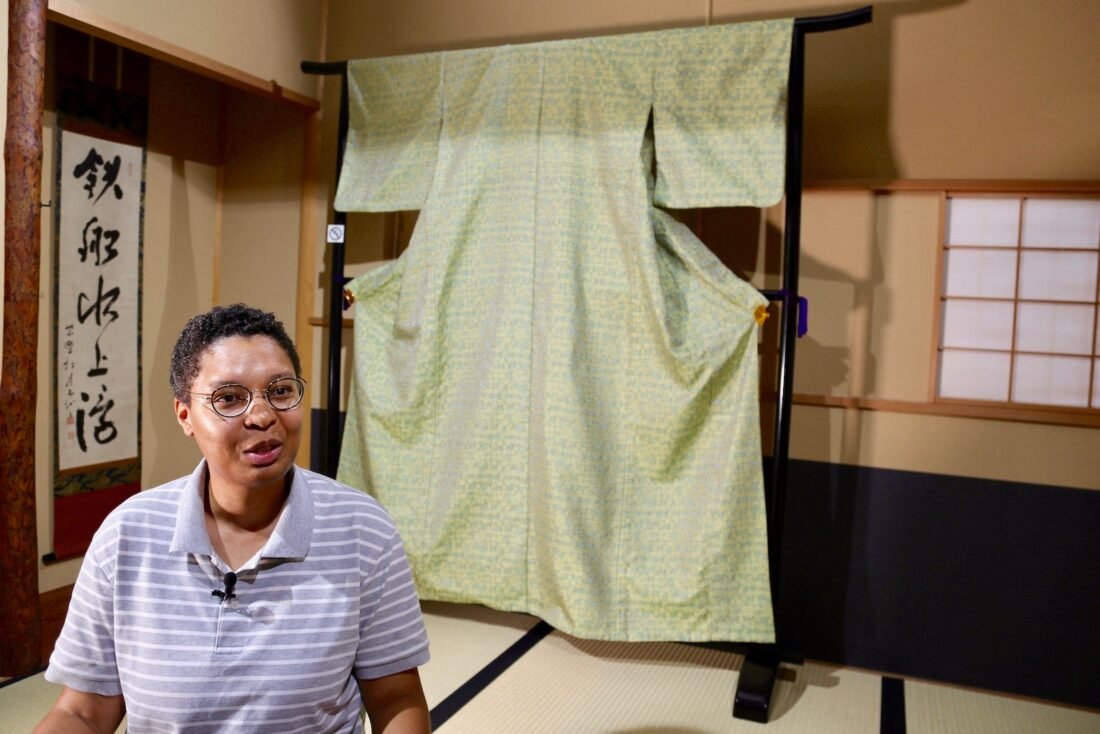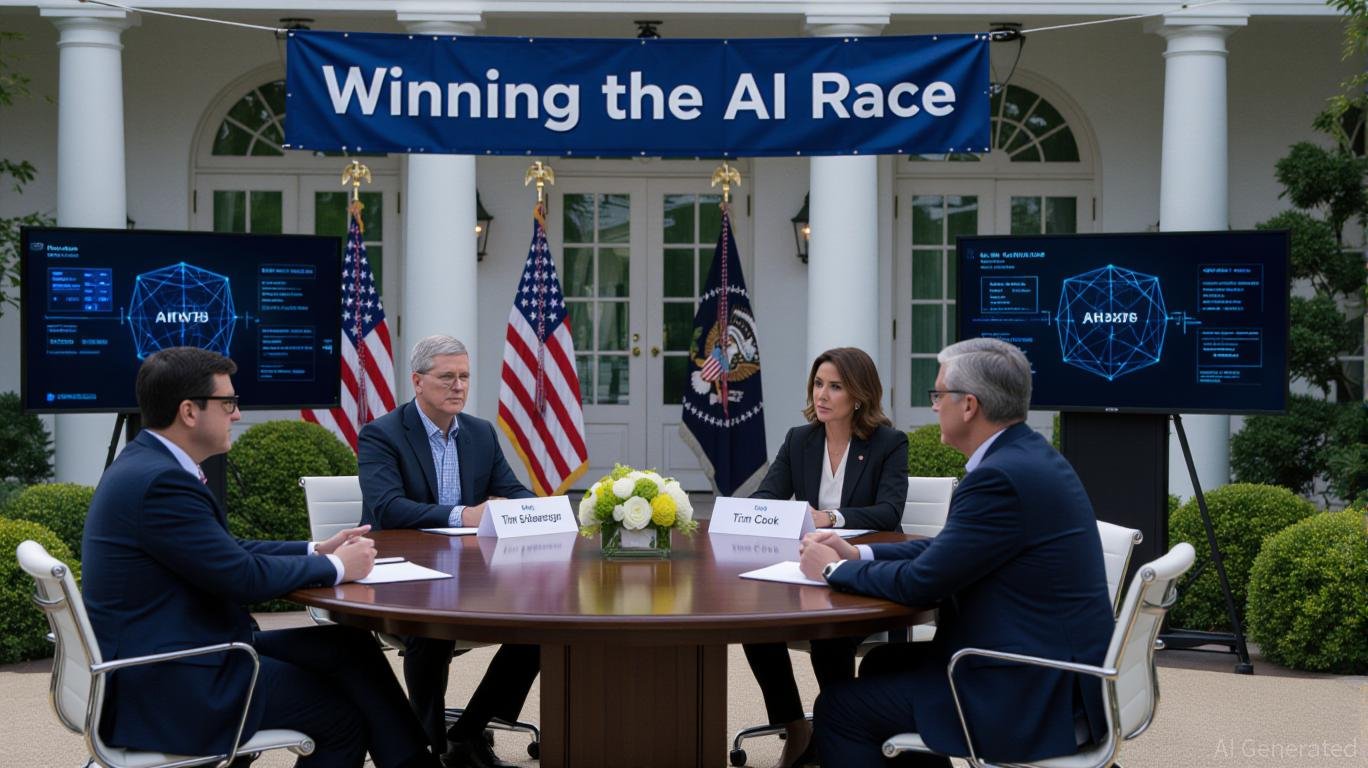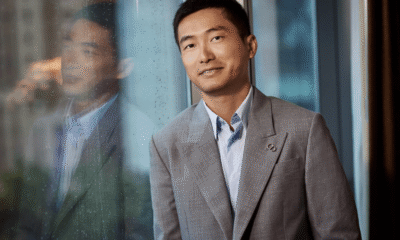Tools & Platforms
Tradition meets AI: Nishijinori weaving style from ancient Japan utilizes modern tech | News, Sports, Jobs

- Lana Sinapayen, associated researcher at Sony Computer Science Laboratories, speaks with The Associated Press about the Nishijinori AI project with the fabric in the background in Kyoto, western Japan on July 3, 2025. (AP Photo/Yuri Kageyama)

Lana Sinapayen, associated researcher at Sony Computer Science Laboratories, speaks with The Associated Press about the Nishijinori AI project with the fabric in the background in Kyoto, western Japan on July 3, 2025. (AP Photo/Yuri Kageyama)
KYOTO, Japan (AP) — Nishijinori, the intricate weaving technique for kimonos that dates back more than a thousand years in Japan’s ancient capital of Kyoto, is getting a high-tech collaborator: artificial intelligence.
The revered colorful weaving style associated with “The Tale of Genji” of the 11th-century Heian era, has gone through its share of ups and downs. But its survival is more perilous than ever today, as demand for kimonos nose-dives among Japanese grappling with modernization.
Hironori Fukuoka, the fourth-generation successor to his Nishijinori business, is determined to keep alive the art he’s inherited, even if that means turning to AI.
“I want to leave to legacy what my father has left for me,” he said in his rickety shop in the Nishijin district of Kyoto, a city with statue-filled temples and sculpted gardens that never seems to change.
“I’ve been pondering how the art of Nishijinori can stay relevant to the needs of today,” said Fukuoka.
Besides the AI project, Fukuoka is also working on using his weaving technique to make super-durable materials for fishing rods and aircraft.
Where tradition and technology meet
Giant looms clatter at his shop, called Fukuoka Weaving. The patterns on the gorgeous fabric, slowly turning out from the loom, are repetitive and geometric, which makes it conducive to translating into digital data. Deciding which hand-dyed color thread goes where to make the patterns is much like the on-or-off digital signals of a computer.
Such similarity is what Fukuoka focuses on in exploring how AI might work for Nishijinori, with the help of Sony Computer Science Laboratories, an independent research arm of electronics and entertainment company Sony Corp.
AI only makes suggestions for the designs and doesn’t do any of the actual production work. But that doesn’t bother Fukuoka or the researchers.
“Our research stems from the idea that human life gets truly enriched only if it has both what’s newly innovated and what never changes,” said Jun Rekimoto, chief science officer at Sony CSL, which is also studying how AI can be used to document and relay the moves of a traditional Japanese tea ceremony.
“We don’t believe AI can do everything. Nishijinori is a massive, complicated industry and so it starts with figuring out where AI can help out,” said Rekimoto, also a professor at the University of Tokyo.
What has come of it is a startling but logical turn in thinking, fitting of the art adorning kimonos worn by Japan’s imperial family.
The AI was fed various Nishijinori patterns that already existed and instructed to come up with its own suggestions. One was a bold pattern of black and orange that seemed to evoke a tropical motif.
Striking a balance
To Fukuoka, some of AI’s ideas are interesting but simply off. The difference between AI and the human effort is that the former can come up with multiple suggestions in a matter of seconds.
Fukuoka immediately gravitates toward the one that uses a motif of a leaf to define the angular lines of a traditional pattern, something he says a human wouldn’t have thought of. He finds that ingenious.
The kimono the AI collaboration has produced is a luscious soft green, although it doesn’t have a price tag and isn’t in production yet.
The weaving is carried out by the old-style machine under the guidance of the human artist in the traditional way.
Nishijinori kimonos sell for as much as a million yen ($6,700). Many Japanese these days don’t bother buying a kimono and may rent it for special occasions like weddings, if at all.
Putting one on is an arduous, complicated affair, often requiring professional help, making kimonos even less accessible.
A creative partnership
Dr. Lana Sinapayen, associate researcher at Sony CSL, believes AI often gets assigned the creative, fun work, leaving tedious tasks to people, when it should be the other way around.
“That was my goal,” she said in an interview at Fukuoka Weaving, of her intent to use AI in assistant roles, not leadership positions.
Digital technology can’t automatically represent all the color gradations of Nishijinori. But AI can figure out how to best do that digitally, and it can also learn how the human artist fixes the patterns it has produced.
Once that’s all done, AI can tackle arduous tasks in a matter of seconds, doing a pretty good job, according to the researchers.
Artificial intelligence is being used widely in factories, offices, schools and homes, because it can do tasks faster and in greater volume, and is usually quite accurate and unbiased, compared to human efforts. Its spread has been faster in the U.S. and other Western nations than in Japan, which tends to be cautious about change and prefers carefully made, consensus-based decisions.
But the use of AI in arts and crafts is promising, such as text-to-image generative AI for the creation of visual images from text prompts, according to a study by Henriikka Vartiainen and Matti Tedre, who looked at the use of AI by craft educators in Finland.
“As computers have taken over many routine-like and boring tasks that were previously performed by people, the computer revolution has also been said to liberate time and offer new opportunities for human imagination and creativity,” they said.
Tools & Platforms
A Strategic Inflection Point for AI and Corporate Alignment

The Trump administration’s recent AI Action Plan and the high-profile Tech Summit in the newly renovated White House Rose Garden mark a pivotal recalibration of U.S. technology policy. By aligning corporate priorities with federal deregulatory ambitions, the administration is reshaping the investment landscape for artificial intelligence. This analysis explores the strategic implications of this alignment, focusing on how Trump’s policies are redefining risk, reward, and global competitiveness in the AI sector.
Deregulation as a Catalyst for Innovation
The administration’s AI Action Plan, unveiled on July 23, 2025, prioritizes accelerating innovation through regulatory rollbacks. Over 90 federal policy actions aim to remove barriers to AI development, including streamlined permitting for data centers and reduced environmental restrictions on infrastructure projects [2]. For instance, the use of categorical exclusions under the National Environmental Policy Act (NEPA) now expedites data center construction, a move that could unlock billions in private investment. According to a report by Bloomberg, this deregulatory push has already spurred a 20% surge in capital expenditures by hyperscale cloud providers in Q3 2025 [4].
The emphasis on “ideological neutrality” in federal AI procurement, formalized via the “Preventing Woke AI” executive order, further signals a shift in priorities. By mandating that AI models adhere to “truth-seeking” principles, the administration is fostering a market environment where companies like Nvidia and Microsoft—whose open-weight models align with these guidelines—stand to gain significant federal contracts [5]. This creates a dual opportunity: firms that adapt to the new framework may secure lucrative government partnerships, while those lagging in compliance risk marginalization.
Infrastructure and Export-Driven Growth
A cornerstone of the AI Action Plan is the push to build domestic AI infrastructure, including semiconductors and data centers. The administration’s call for a single federal standard—replacing a patchwork of state-level regulations—has already influenced investor behavior. Morgan Stanley notes that tech stocks in the S&P 500 accounted for 80% of the index’s gains in 2025, with AI-related equities outperforming by a 15-point margin [4]. This trend is amplified by the administration’s focus on exporting the “American AI Technology Stack” to allies, a strategy that could expand markets for U.S. firms while countering Chinese influence [3].
However, this infrastructure push is not without risks. Critics warn that reduced environmental oversight could lead to long-term costs, such as energy grid strain and ecological damage. Yet, the administration’s commitment to modernizing the power grid—part of its AI Action Plan—suggests a calculated effort to mitigate these concerns through public-private partnerships [5].
Corporate Alignment and Investor Sentiment
The Trump administration’s summit with tech leaders like Mark Zuckerberg, Tim Cook, and Bill Gates underscores a deliberate effort to harmonize corporate and federal agendas. This alignment has translated into investor confidence: since the plan’s announcement, the S&P 500’s AI-driven gains have surged, with Nvidia’s market cap alone rising by $1.2 trillion in six months [1].
Yet, this optimism is tempered by divergent regulatory pressures. While the federal government promotes deregulation, states like California and New York have maintained stricter AI oversight. This creates a “regulatory arbitrage” scenario, where companies may prioritize federal-aligned strategies to access funding and contracts, even if it means sidestepping state-level safeguards [2]. For investors, this duality presents both opportunities (e.g., scalable AI deployments) and risks (e.g., reputational damage from perceived ethical lapses).
Strategic Implications for Investors
The administration’s focus on global AI leadership—through alliances with like-minded nations and export controls—positions U.S. tech firms to dominate emerging markets. However, the lack of detailed implementation timelines in the AI Action Plan raises questions about execution risks [6]. Investors should prioritize companies with robust supply chains and geopolitical agility, such as semiconductor manufacturers and cybersecurity firms.
Conversely, sectors reliant on state-level regulations (e.g., healthcare AI with privacy mandates) may face headwinds. The administration’s discouragement of state-level AI rules—via funding decisions tied to regulatory climates—could force firms to choose between compliance and profitability [1].
Conclusion
Trump’s Tech Summit and AI Action Plan represent a strategic inflection point, redefining the interplay between corporate innovation and federal policy. While deregulation and infrastructure investment offer clear tailwinds for tech stocks, investors must navigate the tension between short-term gains and long-term risks. The administration’s emphasis on ideological neutrality and global competitiveness suggests a market environment where alignment with federal priorities will increasingly dictate success. For now, the data—and the market—seem to be on the administration’s side.
Source:
[1] The Trump Administration’s 2025 AI Action Plan [https://www.sidley.com/en/insights/newsupdates/2025/07/the-trump-administrations-2025-ai-action-plan]
[2] Tech companies want to move fast. Trump’s ‘AI Action Plan’ [https://www.latimes.com/business/story/2025-07-23/trump-unveils-ai-action-plan]
[3] Trump AI Summit Targets Hardware as Key to US Supremacy [https://www.bloomberg.com/news/newsletters/2025-07-28/trump-ai-summit-targets-hardware-as-key-to-us-supremacy]
[4] Q2 2025 Market Perspective [https://altiumwealth.com/blogs/altium-insights/q2-2025-market-perspective]
[5] Trump Administration Unveils AI Action Plan with … [https://www.mayerbrown.com/en/insights/publications/2025/07/trump-administration-unveils-ai-action-plan-with-implications-for-innovation-infrastructure-and-global-tech-competition]
[6] Inside Trump’s Ambitious AI Action Plan | Stanford HAI [https://hai.stanford.edu/news/inside-trumps-ambitious-ai-action-plan]
Tools & Platforms
AI, lasers and chips: the science and tech of China’s military parade

China’s military parade on Wednesday – featuring the latest AI-powered uncrewed vehicles, laser weapons and missiles – signalled an arms race fuelled by scientific and technological advances.
Artificial intelligence, optics and physics and information technologies have underscored how innovations will shape the future of modern warfare, paving the way for futuristic intelligent systems.
“The parade featured unmanned intelligent systems, underwater combat units, cyber and electronic forces and hypersonic weapons, highlighting the growing capacity of the People’s Liberation Army (PLA) to harness emerging technologies, adapt to the evolving character of warfare, and prevail in future conflicts,” state broadcaster CCTV said.
The weapons on parade featured a “high level of informatisation, intelligence and practical combat capability, showcasing the military’s combat abilities, capabilities in new domains and strong strategic deterrence”, Dong Yongzai, a researcher at a centre under Beijing’s Academy of Military Science, told CCTV.
AI-powered equipment and vehicles
The parade showcased a variety of AI-powered uncrewed equipment.
The land combat formation showed vehicles that can perform reconnaissance, assaults, mine and bomb defusing and squad support, according to CCTV.
Tools & Platforms
Janus Health Joins Cipher Collective as Revenue Cycle Technology Provider in AI-Enabled Healthcare Initiative – geneonline.com
-

 Business5 days ago
Business5 days agoThe Guardian view on Trump and the Fed: independence is no substitute for accountability | Editorial
-
Tools & Platforms3 weeks ago
Building Trust in Military AI Starts with Opening the Black Box – War on the Rocks
-

 Ethics & Policy1 month ago
Ethics & Policy1 month agoSDAIA Supports Saudi Arabia’s Leadership in Shaping Global AI Ethics, Policy, and Research – وكالة الأنباء السعودية
-

 Events & Conferences4 months ago
Events & Conferences4 months agoJourney to 1000 models: Scaling Instagram’s recommendation system
-

 Jobs & Careers2 months ago
Jobs & Careers2 months agoMumbai-based Perplexity Alternative Has 60k+ Users Without Funding
-

 Education2 months ago
Education2 months agoVEX Robotics launches AI-powered classroom robotics system
-

 Funding & Business2 months ago
Funding & Business2 months agoKayak and Expedia race to build AI travel agents that turn social posts into itineraries
-

 Podcasts & Talks2 months ago
Podcasts & Talks2 months agoHappy 4th of July! 🎆 Made with Veo 3 in Gemini
-

 Podcasts & Talks2 months ago
Podcasts & Talks2 months agoOpenAI 🤝 @teamganassi
-

 Education2 months ago
Education2 months agoAERDF highlights the latest PreK-12 discoveries and inventions



















